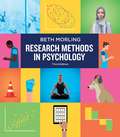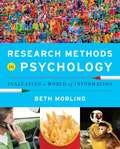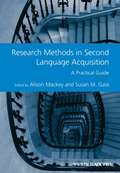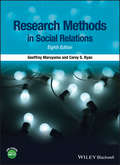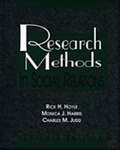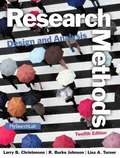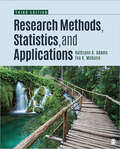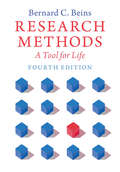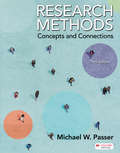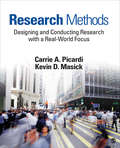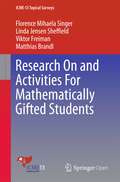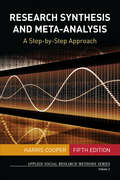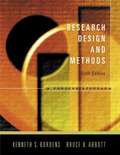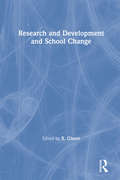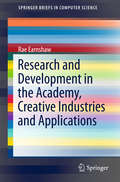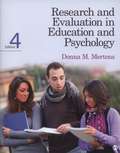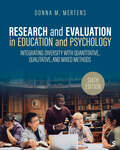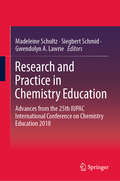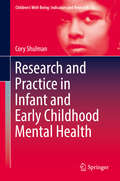- Table View
- List View
Research Methods in Psychology: Evaluating A World of Information
by Beth MorlingIn this book, students learn how to design research studies but they also see the value of evaluating research claims they encounter in daily life. The Third Edition provides new ways for students to practice what they learn. <p><p> NEW Working It Through examples provide a step-by-step method for evaluating claims start-to-finish, and a NEW adaptive learning tool, InQuizitive, enables students to practice what they've learned and strengthened their comprehension.
Research Methods in Psychology: Evaluating a World of Information
by Beth MorlingEven though few psychology majors end up pursuing a career as a researcher in the field, Morling (U. of Delaware) wants to enable them to become critical consumers of research. Rather than the typical research methods text emphasis on research production, she concentrates on tools for evaluating research claims. The text features a "Three Claims, Four Validities" framework for identifying and evaluating claims; learning activities; and overviews of descriptive statistics, inferential statistics, presenting research reports in APA style; statistical tables; and a glossary. Annotation ©2012 Book News, Inc. , Portland, OR (booknews. com)
Research Methods in Psychology: Investigating Human Behavior
by Russell K. Schutt Paul G. NestorResearch Methods in Psychology: Investigating Human Behavior draws on fascinating stories to illustrate the entire research process within a unifying conceptual framework. Bestselling authors Paul G. Nestor and Russell K. Schutt present a clear and comprehensive introduction to the logic and techniques of research methods in psychology by employing a unique combination of two distinct yet complementary pedagogical techniques. First, chapters designed for experiential, hands-on studies put the student in the roles of researcher, participant, and consumer to bring concepts to life. Second, the findings of cognitive science guide the text in a way that is most conducive to learning. This novel approach serves as an effective way to make the world of psychological research fun and rewarding for students, in addition to allowing them to gain the foundational knowledge they need to design, conduct, and present research.
Research Methods in Psychology: Investigating Human Behavior
by Russell K. Schutt Paul G. NestorResearch Methods in Psychology: Investigating Human Behavior draws on fascinating stories to illustrate the entire research process within a unifying conceptual framework. Bestselling authors Paul G. Nestor and Russell K. Schutt present a clear and comprehensive introduction to the logic and techniques of research methods in psychology by employing a unique combination of two distinct yet complementary pedagogical techniques. First, chapters designed for experiential, hands-on studies put the student in the roles of researcher, participant, and consumer to bring concepts to life. Second, the findings of cognitive science guide the text in a way that is most conducive to learning. This novel approach serves as an effective way to make the world of psychological research fun and rewarding for students, in addition to allowing them to gain the foundational knowledge they need to design, conduct, and present research.
Research Methods in Second Language Acquisition: A Practical Guide
by Alison Mackey Susan M. GassResearch Methods in Second Language Acquisition: A Practical Guideis an informative guide to research design and methodology for graduate students and scholars. Each chapter of this volume offers background, step-by-step guidance, and relevant studies to create comprehensive coverage of each method. Includes chapters by expert scholars on an array of topics, including second language writing and reading, meta-analyses, research replication, qualitative data collection and analysis, and more Includes feature boxes in each chapter highlighting relevant research studies, discussion questions and suggested further readings Utilizes research methods and tools from varied fields of study including education, linguistics, psychology, and sociology
Research Methods in Social Relations
by Geoffrey Maruyama Carey S. RyanResearch Methods in Social Relations, 8th Edition, features a series of updates and revisions in its comprehensive introduction to current research methods in the social and behavioural sciences.Offers comprehensive coverage of a wide variety of traditional and topical research methodsAddresses many newer research approaches such as propensity score matching, mixed methods designs, and confirmatory factor analysisWritten to be accessible to a range of social and behavioural science disciplines, including public health, political science, sociology, and psychologyIncludes new chapters that engage readers in critical thinking about the processes involved in building sustainable partnerships in field and community settingsThe Companion website includes an array of resources for Instructors, including Test Banks, Power Point lecture slides, discussion questions and exercisesThis new edition is the much-anticipated follow-up to 2001's seventh edition by Hoyle, Harris and Judd
Research Methods in Social Relations (7th edition)
by Rick H. Hoyle Monica J. Harris Charles M. JuddA problem-focused perspective to social science methods.
Research Methods in the Study of Substance Abuse
by Timothy P. Johnson Jonathan B. Vangeest Sonia A. AlemagnoThis authoritative handbook reviews the most widely-used methods for studying the use and abuse of alcohol and illegal drugs. Its thorough coverage spans the range of quantitative, qualitative, and mixed-method approaches to documenting and measuring the complex psychological, behavioral, and physical experience of substance misuse and dependence, to ensure valid, useful results. Experts discuss special issues and considerations for conducting ethical research with specialized populations, including youth, inmates, and the LGBT community. Throughout these chapters, contributors demonstrate the multidisciplinary nature of substance abuse research, with emphasis on professional ethics and the critical role of research in developing best practices and effective policy for prevention and treatment. Among the topics covered: #65533; Transdisciplinary research perspective: a theoretical framework for substance abuse research #65533; Longitudinal methods in substance use research #65533; Considerations in blending qualitative and quantitative components in substance abuse research #65533; The use of biological measures in social research on drug misuse #65533; Using surveys to study substance use behavior #65533; Applications of GIS to inform substance abuse research and interventions #65533; Evaluating substance use prevention and treatment programs Research Methods in the Study of Substance Abuse is an essential resource for health services and public health professionals, policymakers, and researchers working and training in the field of addiction. It encourages the rigor and understanding necessary to address widespread social and public health concerns.
Research Methods, Design, and Analysis (Twelfth Edition)
by Larry B. Christensen R. Burke Johnson Lisa A. TurnerResearch Methods, Design, and Analysis, 12/e, provides an understanding of the research methods used to investigate human thought and behavior. The coverage of experimental, qualitative, correlational, and survey research helps students develop their research skills for all aspects of psychology. Information is presented in a simple and straightforward manner and placed into context of actual research studies, helping students make real-life connections.
Research Methods, Statistics, and Applications
by Kathrynn A. Adams Eva Kung McGuire (aka: Lawrence)Research Methods, Statistics, and Applications by Kathrynn A. Adams and Eva K. McGuire is designed to give students the experience of being a researcher by combining the interrelated concepts of research methods and statistics to better explain how the research process incorporates both elements. Employing a conversational tone throughout, coupled with an emphasis on decision-making, this best-selling text will spark students’ interest in conducting research and improve their ability to critically analyze research in their daily lives. The Third Edition includes a new chapter on measurement to better highlight its critical importance, updates for the 7th edition of the Publication Manual of the American Psychological Association, new examples related to social justice, additional sections on qualitative research methods, and more thorough integration of research ethics information and tips throughout each chapter.
Research Methods, Statistics, and Applications
by Kathrynn A. Adams Eva Kung McGuire (aka: Lawrence)Research Methods, Statistics, and Applications by Kathrynn A. Adams and Eva K. McGuire is designed to give students the experience of being a researcher by combining the interrelated concepts of research methods and statistics to better explain how the research process incorporates both elements. Employing a conversational tone throughout, coupled with an emphasis on decision-making, this best-selling text will spark students’ interest in conducting research and improve their ability to critically analyze research in their daily lives. The Third Edition includes a new chapter on measurement to better highlight its critical importance, updates for the 7th edition of the Publication Manual of the American Psychological Association, new examples related to social justice, additional sections on qualitative research methods, and more thorough integration of research ethics information and tips throughout each chapter.
Research Methods: A Tool for Life
by Bernard C. BeinsResearch Methods is an introduction to the importance of scientific research in everyday life and uses familiar examples to keep students engaged. The text analyzes controversies in psychology to stimulate student interest while explaining crucial methodological concepts. It presents ethical issues related to research, as well as social and cultural factors that might affect it, and provides a comprehensive introduction to a wide variety of methodologies. Through this book, students will learn how to generate research questions and select appropriate methodology, as well as to write a successful research report.
Research Methods: Concepts and Connections
by Michael PasserWith over two decades of classroom experience, Michael Passer knows how to guide students through the ins and outs of research methods. In this remarkable text, Passer’s experience leads to chapters filled with clear explanations, resonant examples, and contemporary research from across the breadth of modern psychology, all while anticipating common questions and misunderstandings.
Research Methods: Designing and Conducting Research With a Real-World Focus
by Carrie A. Picardi Kevin D. Masick Inc. Sage PublicationsResearch Methods: Designing and Conducting Research with a Real-World Focus provides the tools required to conduct relevant, high-quality research in both the classroom and the field. Carrie A. Picardi and Kevin D. Masick—psychologists with expertise in both teaching research methods and applying methods to diverse field settings—offer a unique perspective by integrating current research articles with field-specific scenarios. They draw from research methodology tactics, strategy, and constraints from practitioners across the social sciences and in business. This text effectively bridges the gap between theory and practice by demonstrating how research is done within an organizational setting, and supplies students with relevant, applicable examples to learn from.
Research On and Activities For Mathematically Gifted Students (ICME-13 Monographs)
by Linda Jensen Sheffield Florence Mihaela Singer Viktor Freiman Matthias BrandlThis Topical Survey offers a brief overview of the current state of research on and activities for mathematically gifted students around the world. This is of interest to a broad readership, including educational researchers, research mathematicians, mathematics teachers, teacher educators, curriculum designers, doctoral students, and other stakeholders. It first discusses research concerning the nature of mathematical giftedness, including theoretical frameworks and methodologies that are helpful in identifying and/or creating mathematically gifted students, which is described in this section. It also focuses on research on and the development of mathematical talent and innovation in students, including connections between cognitive, social and affective aspects of mathematically gifted students. Exemplary teaching and learning practices, curricula and a variety of programs that contribute to the development of mathematical talent, gifts, and passion are described as well as the pedagogy and mathematics content suitable for educating pre-service and in-service teachers of mathematically gifted students. The final section provides a brief summary of the paper along with suggestions for the research, activities, and resources that should be available to support mathematically gifted students and their teachers, parents, and other stakeholders.
Research Synthesis and Meta-Analysis: A Step-by-Step Approach (Applied Social Research Methods #2)
by Harris CooperThe Fifth Edition of Harris Cooper′s bestselling text offers practical advice on how to conduct a synthesis of research in the social, behavioral, and health sciences. The book is written in plain language with four running examples drawn from psychology, education, and health science. With ample coverage of literature searching and the technical aspects of meta-analysis, this one-of-a-kind book applies the basic principles of sound data gathering to the task of producing a comprehensive assessment of existing research.
Research Synthesis and Meta-Analysis: A Step-by-Step Approach (Applied Social Research Methods #2)
by Harris CooperThe Fifth Edition of Harris Cooper′s bestselling text offers practical advice on how to conduct a synthesis of research in the social, behavioral, and health sciences. The book is written in plain language with four running examples drawn from psychology, education, and health science. With ample coverage of literature searching and the technical aspects of meta-analysis, this one-of-a-kind book applies the basic principles of sound data gathering to the task of producing a comprehensive assessment of existing research.
Research and Design Methods
by Kenneth S. Bordens Bruce B. AbbottA textbook about researching and designing psychological studies and experiments.
Research and Development and School Change
by Benjamin S. Bloom; Joseph M. Cronin; Robert M. Gagné; Jacob W. Getzels; Wayne H. Holtzman; Wesley W. Posvar; Alberta E. Siegel; Ralph W. Tyler; Robert GlaserFirst published in 1983. The essays in this book are based on papers presented at a symposium held in March 1976 at the Learning and Development Center (LRDC), University of Pittsburgh. It was planned to serve three purposes: to pay tribute to retiring chairman Ralph W. Tyler, to mark the dedication of LRDC's new buiding and to provide an opportunity for those involved in research and development to reflect further on its implications for school change.
Research and Development in the Academy, Creative Industries and Applications
by Rae EarnshawThis book examines how creativity feeds through into typical application areas, and the lessons that can be learned from this. A number of Case Studies in creative and general application domains are included which illustrate how the academy and industry can collaborate to mutual benefit and advantage. It also examines the pros and cons of the collaboration, and what lessons can be learned from successes or failures in aspects of the implementation and delivery. The academy has played a key role in the past in the research and development of key ideas and patents that have been migrated into successful industrial products and services and continues to do so. A variety of models of interaction between the academy and industry have been developed depending on the circumstances of the institution, its mission, its values, its expertise, and its relationship to the local and cultural environment in which it is situated. These models are reviewed and evaluated. The process of initial idea through to design and successful implementation is a pipeline. If this process requires the involvement of technology (as is more often the case - as creative applications are increasingly dependent on technology) then there is need to understand how this can efficiently and optimally be done. A number of factors tend to be generic and permeate many application areas (such as bandwidth requirements, use of colour, interaction methods) whilst others are more customized with specialist hardware and software (e. g. shared virtual environments, augmented reality).
Research and Evaluation in Education and Psychology (Fourth Edition)
by Donna M. MertensFocused on increasing the credibility of research and evaluation, the Fourth Edition of Donna M. Mertens's comprehensive Research and Evaluation in Education and Psychology: Integrating Diversity with Quantitative, Qualitative, and Mixed Methods incorporates the viewpoints of various research paradigms into its descriptions of these methods. Providing specific advice on conducting research in culturally complex communities, the new edition has been updated to align with the American Psychological Association and the National Council of Accreditation of Teacher Education accreditation requirements. Approximately sixty percent of the content in the Fourth Edition is new, updated with numerous contemporary examples, making this book one of the most comprehensive, accessible, and practical methods books available.
Research and Evaluation in Education and Psychology: Integrating Diversity With Quantitative, Qualitative, and Mixed Methods
by Donna M. MertensIdentify, evaluate, and practice good research using Research and Evaluation in Education and Psychology: Integrating Diversity With Quantitative, Qualitative, and Mixed Methods by renowned scholar Donna M. Mertens. This introductory research methods text incorporates the viewpoints of various research paradigms into its descriptions of qualitative, quantitative, and mixed methods as well as program evaluation. The work covers five major paradigms: post-positivist, constructivist, transformative, pragmatic, and Indigenous. Special emphasis on conducting research with culturally complex communities, based on the perspectives of feminists, ethnic/racial minorities, and people with disabilities is a hallmark of this text. In each chapter, the author carefully explains each step of the research process, from the literature review to analysis and reporting. Additionally, each chapter includes a published sample study and abstract to illustrate the concepts discussed in that chapter. The Sixth Edition includes more on community engagement, recent advances in mixed methods, new applications of theoretical frameworks, and the latest research examples. Citations and references have all been updated to reflect the seventh edition of the Publication Manual of the American Psychological Association. Included with this title: LMS Cartridge: Import this title’s instructor resources into your school’s learning management system (LMS) and save time. Don’t use an LMS? You can still access all of the same online resources for this title via the password-protected Instructor Resource Site.
Research and Evaluation in Education and Psychology: Integrating Diversity With Quantitative, Qualitative, and Mixed Methods
by Donna M. MertensIdentify, evaluate, and practice good research using Research and Evaluation in Education and Psychology: Integrating Diversity With Quantitative, Qualitative, and Mixed Methods by renowned scholar Donna M. Mertens. This introductory research methods text incorporates the viewpoints of various research paradigms into its descriptions of qualitative, quantitative, and mixed methods as well as program evaluation. The work covers five major paradigms: post-positivist, constructivist, transformative, pragmatic, and Indigenous. Special emphasis on conducting research with culturally complex communities, based on the perspectives of feminists, ethnic/racial minorities, and people with disabilities is a hallmark of this text. In each chapter, the author carefully explains each step of the research process, from the literature review to analysis and reporting. Additionally, each chapter includes a published sample study and abstract to illustrate the concepts discussed in that chapter. The Sixth Edition includes more on community engagement, recent advances in mixed methods, new applications of theoretical frameworks, and the latest research examples. Citations and references have all been updated to reflect the seventh edition of the Publication Manual of the American Psychological Association. Included with this title: LMS Cartridge: Import this title’s instructor resources into your school’s learning management system (LMS) and save time. Don’t use an LMS? You can still access all of the same online resources for this title via the password-protected Instructor Resource Site.
Research and Practice in Chemistry Education: Advances from the 25th IUPAC International Conference on Chemistry Education 2018
by Siegbert Schmid Madeleine Schultz Gwendolyn A. LawrieThis book brings together fifteen contributions from presenters at the 25th IUPAC International Conference on Chemistry Education 2018, held in Sydney. Written by a highly diverse group of chemistry educators working within different national and institutional contexts with the common goal of improving student learning, the book presents research in multiple facets of the cutting edge of chemistry education, offering insights into the application of learning theories in chemistry combined with practical experience in implementing teaching strategies. The chapters are arranged according to the themes novel pedagogies, dynamic teaching environments, new approaches in assessment and professional skills – each of which is of substantial current interest to the science education communities.Providing an overview of contemporary practice, this book helps improve student learning outcomes. Many of the teaching strategies presented are transferable to other disciplines and are of great interest to the global community of tertiary chemistry educators as well as readers in the areas of secondary STEM education and other disciplines.
Research and Practice in Infant and Early Childhood Mental Health
by Cory ShulmanThis book examines infant and early childhood mental health and the importance of early emotional and social development for later developmental trajectories. It incorporates research and clinical perspectives and brings research findings to bear in evaluating intervention strategies. By incorporating empirical developmental literature that is directly relevant to infant mental health and clinical practice, the book addresses the multiple forces which shape young children's mental health. These forces include child factors, parental and familial variables, childrearing practices, and environmental influences. In addition, the book explores parent-child relationships, family networks, and social supports as protective factors, as well as risk factors such as poverty, exposure to violence, and substance abuse, which influence and change developmental processes. It shows that, by examining socio-emotional development in a cultural context, human development in the twenty-first century can be conceptualized through differences, similarities and diversity perspectives, focusing on the rights of every individual child.
